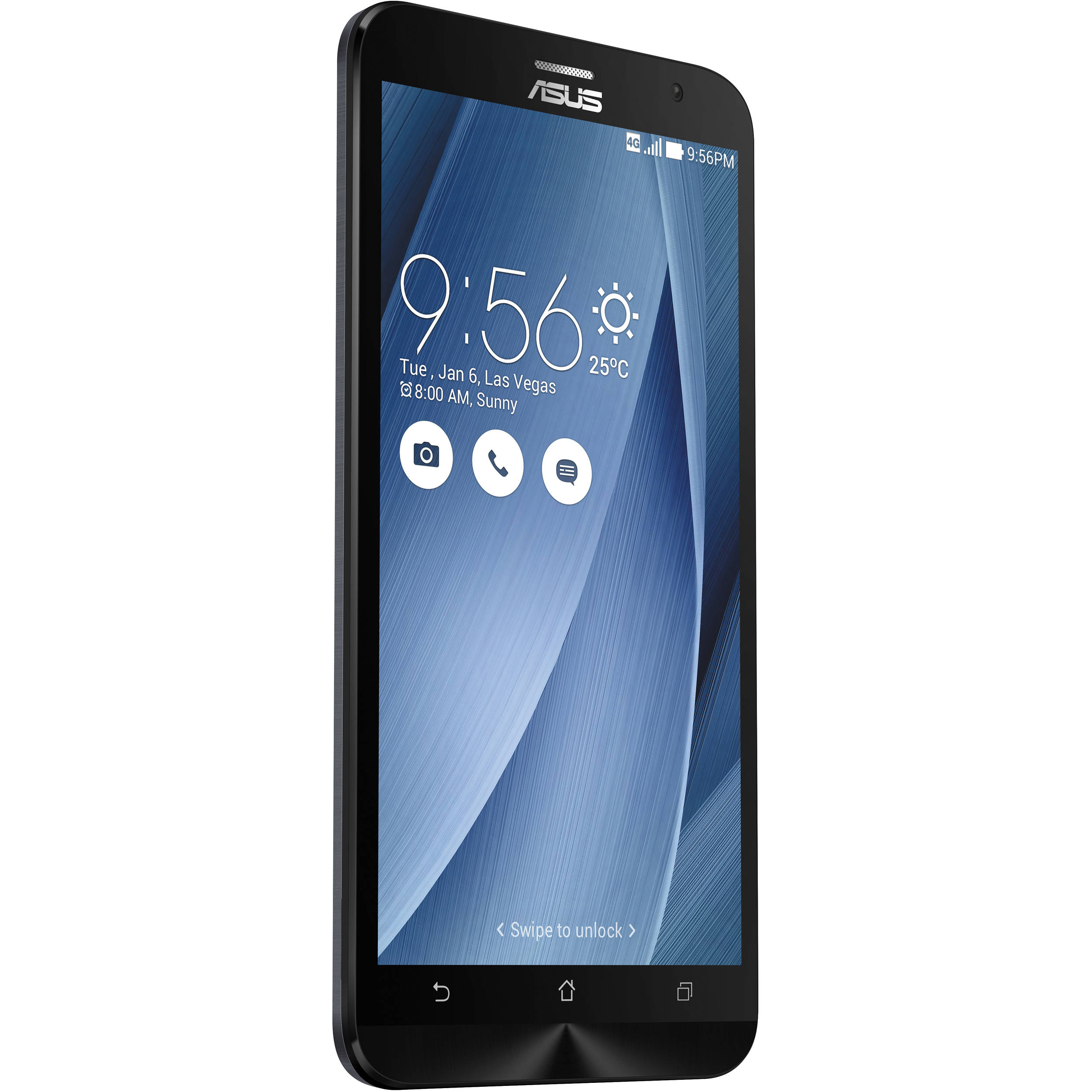Tom's Guide Verdict
With a world's-first 4GB of RAM and U.S.-first Intel Atom CPU, the Asus Zenfone 2 goes toe to toe with other flagship phones for less than half the price.
Pros
- +
Flagship-level performance and 4GB of RAM
- +
Micro SD storage with two micro-SIM slots
- +
Solid performance
- +
Robust camera features
- +
Just $299 unlocked
Cons
- -
Mediocre battery life
- -
Weak speakers
- -
Awkward power-button placement
- -
A bit heavy
Why you can trust Tom's Guide
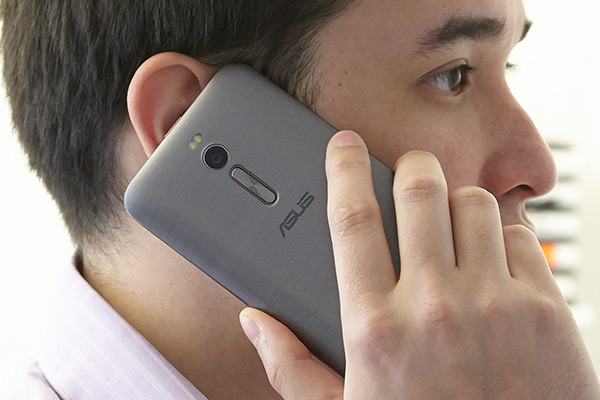
Phones like the Oneplus One and Alcatel Onetouch Idol 3 exposed a weakness in flagship smartphone elitism by offering very competitive packages for significantly less money. But Asus' Zenfone 2 may be the dagger in the heart. Not only is the Zenfone 2 the first phone in the world packing 4GB of RAM, but it's also the first phone in the United States with a 64-bit Intel Atom CPU, instead of the Snapdragons and Exynos processors consumers are used to seeing.
But Asus didn't stop there. The Zenfone 2 boasts a 13-megapixel rear camera with some clever shooting modes, a 5.5-inch full-HD screen, and a removable back with support for two SIM cards and expandable microSD storage. While it involves some trade-offs, such as below-average battery life, the Zenfone 2 really makes you wonder why you'd spend $600 or more on a phone ever again.
Who it's for: Smartphone shoppers willing to go the unlocked route to get very fast performance and a big screen for a low price.
Configurations and Networks
The Zenfone 2 comes in two unlocked flavors: the $299 model with a 2.3-GHz Intel Atom Z3580 CPU, 4GB of RAM and 64GB of onboard storage reviewed here; and a $199 version with a 1.83-GHz Intel Atom Z3560 CPU, 2GB of RAM and 16GB of storage. Both versions will be available direct from Asus' online store, or the typical list of online retailers such as Newegg, Amazon and B&H.
The Zenfone 2 supports the following bands: FDD LTE 1/2/3/4/5/7/8/9/177/18/19/20/28/29, TDD LTE 38/39/40/41, WCDMA 850/900/1900, TD-SCDMA 1900/2100, EDGE/GPRS/GSM 850/900/1800/1900, although network functionality varies from country to country. In the United States, the Zenfone 2 supports both 3G and 4G LTE on T-Mobile and AT&T. You can activate this just by sliding in your SIM.
Design: Like the G4 but with a twist
With a 5.5-inch screen, plastic removable back and rear-mounted volume rocker, the Zenfone 2 strikes more than a passing resemblance to LG's G4. But Asus has incorporated a few traits to give the Zenfone 2 a personality of its own.

In front, the glossy black Zenfone 2 is one of the few phones still championing three capacitive-touch buttons for back, home and menu on its bottom bezel. Below, its chin features a subtle laser-cut concentric-ring finish, which is a birthmark tying it to the design language seen on Asus' other Zen devices.
Get instant access to breaking news, the hottest reviews, great deals and helpful tips.

Annoyingly, Asus put the power/lock button in the middle of the top edge, a move opposing the more common side-placement seen on most phablets. This forces people with smaller hands to awkwardly shimmy their grip up the phone in order to lock the screen. Thankfully, the Zenfone 2 supports tap-to-wake, making a couple quick hits on the screen a much more accessible unlocking alternative, even with just one hand.

The rounded plastic back features a faux brushed-aluminum texture, a 13-megapixel camera sandwiched between the dual-tone flash and elongated volume rocker, and a speaker grille on the bottom. Prying the back off reveals the two slots for micro-SIM cards and one for microSD. You can also see the battery peeking out from behind the plastic shroud, but Asus says it's not user-replaceable (although some intrepid screw-removing owners may beg to differ).
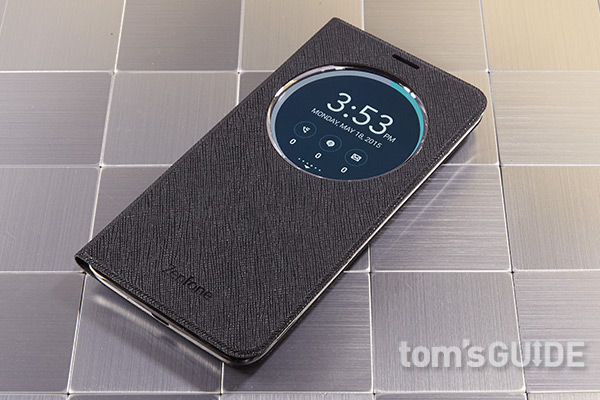
As LG does with the G4, Asus offers additional backs, featuring a multi-faceted crystalline pattern or colored gradients, but nothing in leather. There's no word yet on pricing for these accessories.
At 6 x 3.04 x 0.15-0.43 inches and weighing 6 ounces, the Zenfone 2 is heavier and thicker than other 5.5-inch phablets, such as the LG G4 (5.86 x 3 x 0.24-0.39 inches and 5.47 ounces), Alcatel Onetouch Idol 3 (6.01 x 2.95 x 0.29 inches and 4.85 ounces) and the OnePlus One (6.01 x 2.98 x 0.35 inches and 5.71 ounces).
MORE: Best Smartphones on the Market Now
Display: Colorful but a bit dim
While many phablets have moved to quad-HD screens, the Zenfone 2 holds firm at 1,920 x 1,080 on its 5.5-inch IPS display. The Zenfone 2's blacks looked significantly better than the washed-out grays I saw on Alcatel's Onetouch Idol 3, but not quite as inky as those on AMOLED screens like on the Galaxy S6. The Asus phone also failed to keep DC's heroes in the Legends of Tomorrow trailer from looking like a knock-off version of the Avengers. But it did capture the electric-orange dashes and the Atom's glowing armored suit with the accuracy and excitement to make it entertaining.
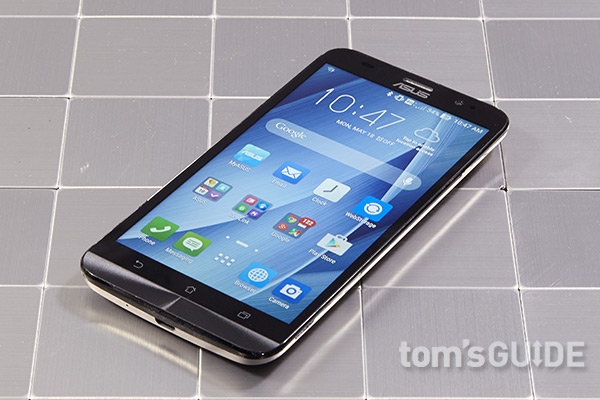
Producing 325 nits of brightness, the Zenfone 2 couldn't quite match the output of screens from the LG G4 (396), Alcatel Onetouch Idol 3 (736 nits) or OnePlus One (432 nits). The difference was most evident outside, where the Zenfone 2's screen was a bit harder to read than the others.
The Zenfone's range of colors is just a few percentage points away from ideal, as its panel reproduced 96 percent of the sRGB spectrum. That's more than the Onetouch Idol 3 (94) and the OnePlus One (93), but less than the LG G4 (110).
The one aspect where the Zenfone 2 fell short was color accuracy, as it notched a Delta-E error rating of 8.5 (closer to zero is better). The LG G4 and Idol 3 both performed better, at 3.5 and 2.6, respectively.
MORE: Best Free Android Apps
The Zenfone 2 also comes with Asus' Splendid display-tuning app, so you can choose from among multiple color profiles. Options include Standard, Reading, Vivid or Auto, or you can create your own using the slider. There's even a Glove mode, so you don't have to worry about buying a new set of touch-screen–friendly hand protectors in the winter.
Audio: Rear-facing speakers just don't cut it
When I first saw the large bezels on the top and bottom of the Zenfone 2, I was hoping Asus had managed to cram front-facing speakers into its phablet. Unfortunately, sound has been relegated to a single speaker on the back. As a result, the Zenfone 2 delivered low volume and weak bass by projecting audio away — and not toward — my ears.
When I listened the Tame Impala's "Eventually," the distorted lows crackled and hissed in protest, while the snare drums sounded shallow and tinny.
Asus' Audiowizard app features several presets for music, movies, gaming and more, and a smart mode for automatically selecting what's best, but it didn't do much to improve the overall audio quality.
ZenUI: A nirvana of gestures and customization
The Zenfone 2 runs Android 5.0 with Asus' ZenUI skin on top. A swipe down from the home screen still opens up the notifications tray, and swiping with two fingers reveals the entire quick-settings menu. A swipe up from the bottom opens the ZenUI launcher, which gives you fast access so you can customize widgets, wallpapers, themes, settings and more.

You can customize almost everything, from the look of the folders and your preferred font, to the animations you see when flipping between screens, with the ability to find new options on Google's Play Store.

ZenUI also adds new gestures to your repertoire, so you can summon your email inbox by tracing a lower case "e" on the screen when it's off, or a "c" to launch right into the camera. You can select up to six different apps in this way, so getting into your favorite app is often just one letter away.
Additionally, Asus includes built-in Trend Micro security to protect you from phishing attempts and malicious software, and a Kids Mode so you can select which apps children are allowed to use, while also blocking incoming calls unless you input a password.
Performance: Flagship-level power for half the price
The performance of the Zenfone 2 distinguishes it not only from other $300 phones, but also catapults it onto nearly the same footing as current flagships.

This comes from Intel's 2.3-GHz quad-core 64-bit Atom Z3580 CPU, a globe-topping 4GB of RAM and 64GB of flash storage. This gives the Zenfone 2 a massive well of power to draw from, like a Corvette idling at a stoplight, so navigating the home screen or playing 1080p movies was always smooth and fluid.
The PowerVR Series 6 G6430 GPU also handled gaming with ease. When I played Mortal Kombat X for Android, the Zenfone 2 never lagged or stuttered, allowing Sub-Zero and me to show Scorpion a grisly demise by way of an icicle made of out of his own frozen heart.
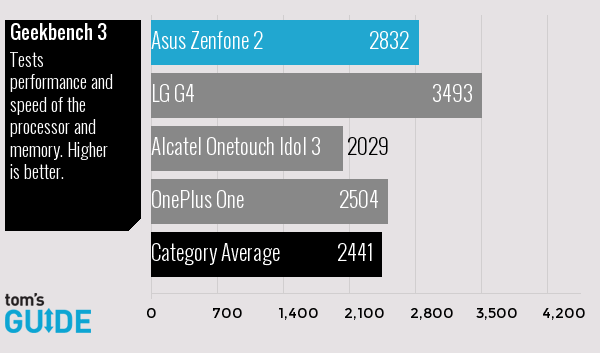
Using Geekbench 3 to measure overall performance, the Zenfone 2 scored 2,832. That's higher than the OnePlus One (2,504) and the Alcatel Onetouch Idol 3 (2,029), but short of the Snapdragon 808-powered LG G4 (3,493). The smartphone average is 2,440.
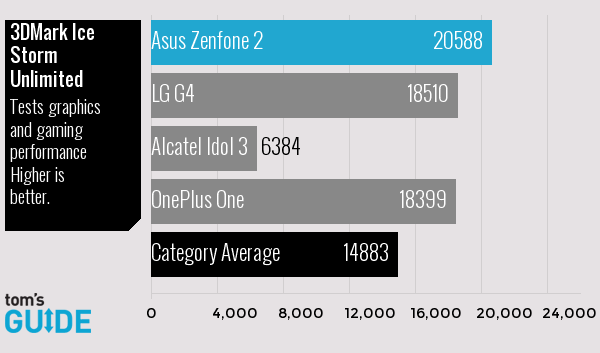
Performance was even better in 3DMark's Ice Storm Unlimited graphics test, in which the Zenfone 2 scored 20,588. That's three times better than the Onetouch Idol 3 (6,384), and also higher than the OnePlus One (18,399), LG G4 (18,510) and smartphone average of 14,883.
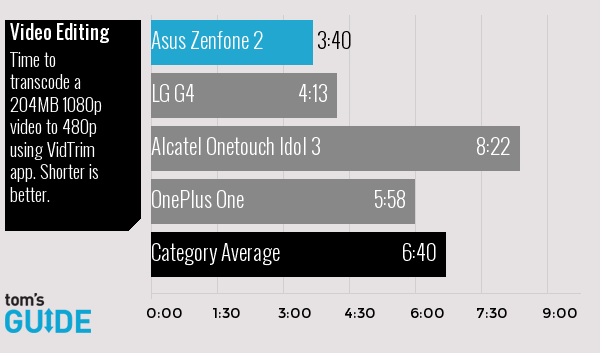
The Zenfone 2 also beat its closest competition when it came to video editing, by converting a 204MB 1080p movie to 480p in just 3 minutes and 40 seconds. That's faster than the Onetouch Idol 3 (8:22), OnePlus One (5:58) and the LG G4 (4:13).
I did notice that occasionally under load, the back of the Zenfone near the camera got a little warm, but it never became too hot to touch. Just once, when using the Boostmaster fast charge after streaming a 1080p movie, a notification popped up saying the CPU had overheated, but after another full day of use, I never saw that message again.
If you’re wondering whether the Intel modem inside the Zenfone 2 offers good 4G LTE performance, it held up well against the Galaxy S6 Edge on T-Mobile’s network. In the same location, the Zenfone 2 averaged 5.6 Mbps downloads and 7.8 Mbps uploads on the Speediest.net app, versus 6.1 Mbps down and 7.3 Mbps up for the Samsung.
Camera: Good, but could use some tweaking
Asus makes some pretty big claims about the cameras in the Zenfone 2, saying they can "See What Others Can't See." While that's true for some of the cameras' advanced shooting modes, their standard auto shots don't have the same kind of prowess as the phone's CPU and RAM.
The Zenfone 2 sports a 13-megapixel Toshiba camera with dual-tone flash and PixelMaster 2.0 tech in the rear, and a 5-MP OmniVision shooter up front, both with apertures of f/2.0. And to see how they performed, I put their pictures up against a similarly priced competitor in the Alcatel Onetouch Idol 3 and my current favorite smartphone camera, the Samsung Galaxy S6.

In a daytime shot, the Zenfone 2's rear camera did a good job capturing One World Trade Center towering over lower Manhattan, with sharp details on the flag in the foreground and buildings in the background. However, I noticed some blown-out highlights in the sky and on the tower of the WTC, details the Samsung Galaxy S6 or similarly priced Onetouch Idol 3 did not miss.
MORE: The Best Smartphone Cameras
The Zenfone 2 struggled indoors, capturing too much yellow when shooting a spread of pears and nectarines, something that, again, did not confuse other cameras.
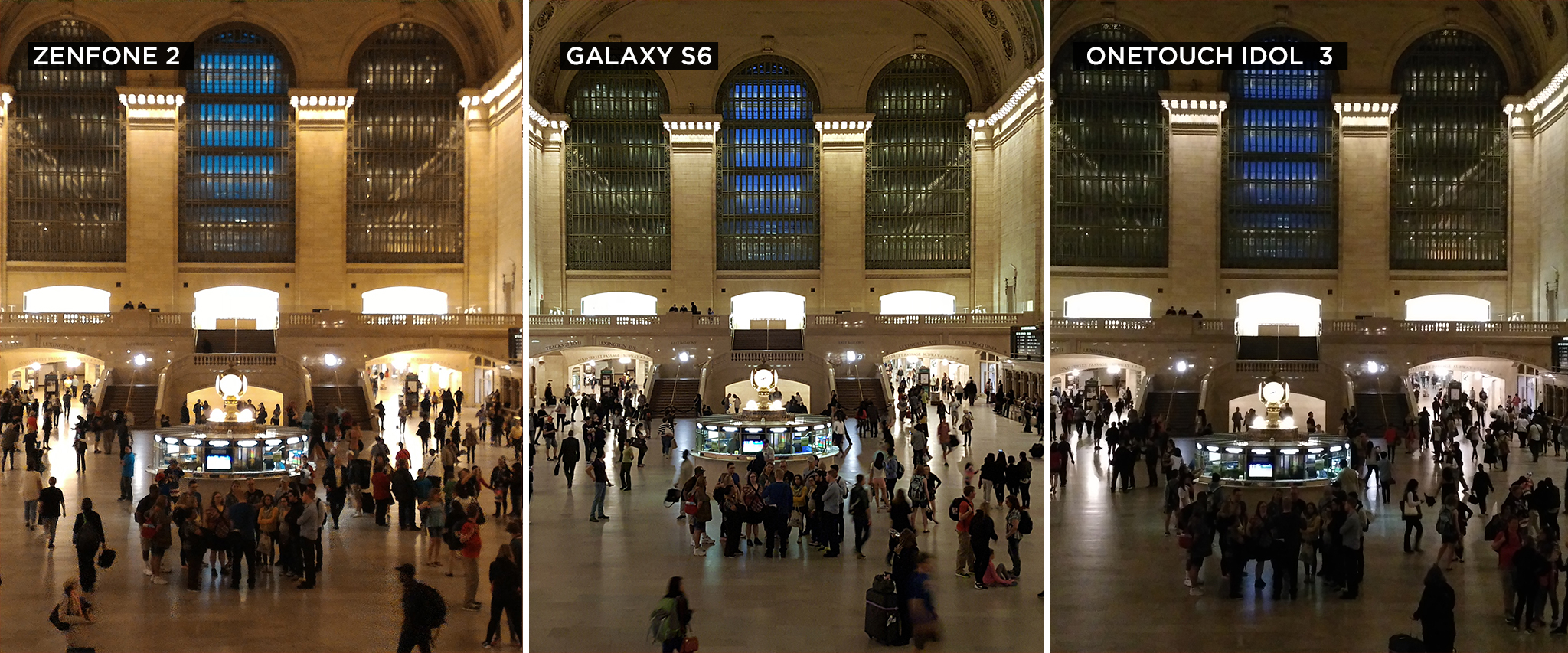
In a low-light shot of the cavernous terminal at Grand Central Station, the Zenfone 2 did better than the underexposed photo of the Onetouch Idol 3. But with its orange color cast, the Zenfone 2's image lacked the color accuracy and detail of the Galaxy S6's shot.

The Zenfone 2's worst shot was the one I took with its dual-tone flash. While this shot did capture accurate skin tones on my roommate's face, it came at the expense of everything else, including too much grain, and harsh highlights. It was a little better than the Alcatel's underexposed shot, but not quite up to the quality of the GS6's photo, which looked a little yellow, but featured even and properly exposed light.

The Zenfone 2 makes selfies simple, because the volume-down button on the rocker doubles as a shutter. With 5 megapixels to work with, shots came out crisp. Even in less-than-ideal light, the Zenfone 2 captured the slight redness in my face from sun exposure the previous day, as well as the varied plaid patterns in my shirt. Just remember that Beauty mode is on by default every time you switch to the front-facing camera, which can make you look like an anime character if the slider is set too high.
Advanced Camera Features: A sight to behold
For more-proficient photographers, Asus adds a manual mode available from the menu in the bottom right (in landscape view) that includes settings for ISO, shutter speed, white balance, exposure compensation and selective focus.
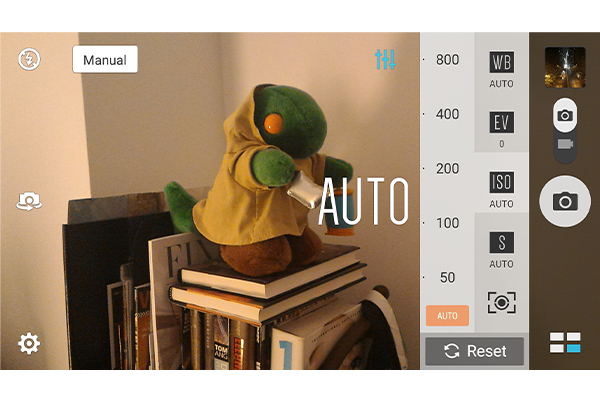
Unfortunately, the options are more limited than what the camera can do in auto mode; I saw shots in auto at ISO 1100, while the highest option in manual was ISO 800.
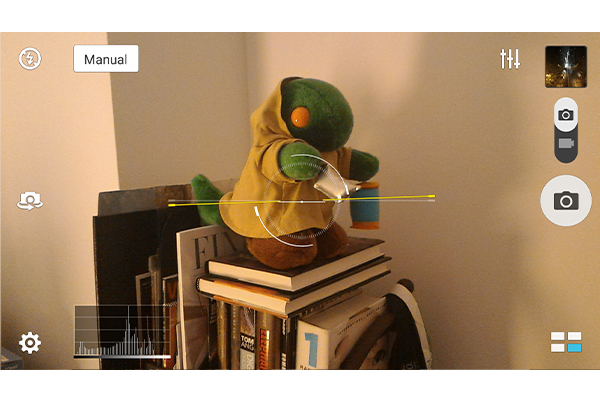
But the best thing about manual mode is the inclusion of a histogram, which is a visual representation of the light and tones in an image. Using this tool, you know your photo will be well exposed even before you take it, and will look good on anyone's screen (important when sending pictures to others).
Asus also touts multiple special modes, the most important ones being SuperHDR, Super Resolution and — my favorite — the low-light mode. SuperHDR promises more detail for backlit photos, combining multiple shots into a single composite image, while Super Resolution combines four 13-MP shots into a 52-MP monster-size photo using what Asus calls Multiframe fusion. Both modes worked well, but if your hands are shaky or the subject isn't well lit, Super Resolution photos come out blurry and grainy.
MORE: Best Photo Editing Software
But the low-light mode really takes the cake by merging four adjacent pixels into one. This cuts resolution from 13 MP to 3 MP, but allows for increased light collection so you can take pictures in places you never thought possible. You even get prompted automatically to enter this mode, by an owl that pops up on the screen, so you don't even need to dive into the menu to select it.
In my room lit only by the glow of my two desktop monitors, the Zenfone 2 captured a stunning picture of my Nikes sitting on top of a Surface 3. By comparison, a shot from the Galaxy S6 looked more like a sad, impressionist painting than a photo, while the shot from the Onetouch Idol 3 didn't come out at all.
Battery Life: Drains fast, charges fast
It seems Intel and Asus still have some work to do on battery efficiency. On the Tom's Guide Battery Test (continuous Web surfing over 4G at 150 nits of brightness), the Zenfone 2's 3,000-mAh battery lasted just 7 hours and 5 minutes.

That's half an hour shorter than the LG G4 (7:38) and an hour less than the smartphone average (8:18). This runtime is also 2 hours less than the Onetouch Idol 3 (9:16), and a far cry from the OnePlus One's 13:16.
MORE: 10 Smartphones with the Longest Battery Life
Fortunately, what the Zenfone 2 lacks in longevity, it compensates for with Boostmaster fast-charging. Starting from 25 percent battery, the Zenfone 2 got back to 72 percent in just 30 minutes, compared to the Idol 3's 50 percent in the same amount of time. A nearby Samsung Galaxys S6 Edge with its Quick Charge 2.0 barely beat the Zenfone's recharging feats by going from 25 percent to 76 percent in the same half hour. It, however, has a smaller, 2,600-mAh battery.
ZenUi Apps: An alternative to Google and a little more
Asus includes more than 20 apps on the Zenfone 2, which mostly provide an alternative to Google apps like Play Music and Photos. However, there are some gems like the AutoStart Manager, which makes it easy to specify which apps start up when you turn on the phone.
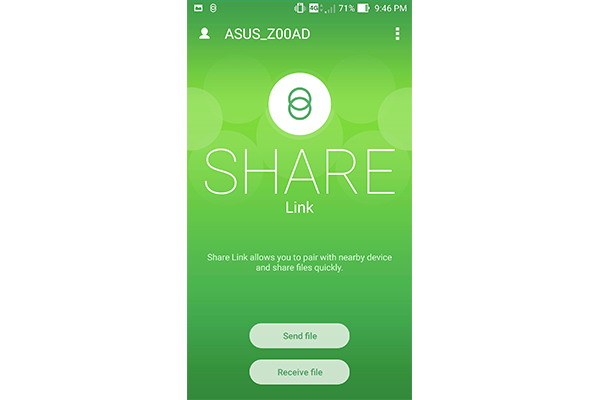
The four ZenLink apps are the best of the bunch, providing super-simple ways to share files and data with another smartphone or PC. The ShareLink app transfers movies, music and even entire apps with just a couple touches over Wi-Fi Direct, so you don't even need Bluetooth or an Internet connection to use it. Because the app is available for free on the Play Store, it works with almost any Android device.

Party Link is the same thing but for multiple devices at the same time, and PC Link pairs the Zenfone to a computer so you can see and control your phone over USB or Wi-Fi. Remote Link allows your Zenfone 2 to operate as a wireless mouse, keyboard or controller for your computer.
Bottom Line
Asus crammed more RAM into its phone than any company before, and its Intel Atom CPU smokes other midrange unlocked phones like the Alcatel Onetouch Idol 3 and OnePlus One. Its removable back plate adds both style (with additional colors and designs) and substance (with access to the microSD and dual SIM card slots). I also appreciate some of the software features Asus included, such as ZenUI Launcher, gesture control and PC Link.

The Zenfone isn't perfect, though. Its battery life is lacking; its rear-facing speakers underwhelm, and the rear camera — even with its advanced shooting modes — can't match the quality of top-tier smartphones. But at $299, it doesn't have to.
You wouldn't be insane for picking a Samsung Galaxy S6 or LG G4 over the Zenfone 2, but you would be crazy for not considering it, and the money you'd save.
Sam is a Senior Writer at Engadget and previously worked at Gizmodo as a Senior Reporter. Before that, he worked at Tom's Guide and Laptop Mag as a Staff Writer and Senior Product Review Analyst, overseeing benchmarks and testing for countless product reviews. He was also an archery instructor and a penguin trainer too (really).
-
togo09 Very good review, Tom, also if you would compare 4GB asus zenfone 2 with 64 GB oneplus one, which one would you preferredReply -
twisterkiran With minimal usage Im getting close to 3 days of Battery life and the Camera is a work of art for those who know a little bit of Photography . I would go on to say that this will be the best phone of 2015 for the price at which it is being offered. And as far as OTA updates is concerned, they are the fastest I guess.On 2 successive Mondays I got OTA updates fixing Yellowish tint in Camera and battery life. Its a great phone all in all. Im super happy. My search for the Incredible has ended. :-)Reply
Cheers,
Kiran Nayaknur
